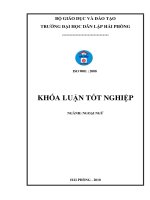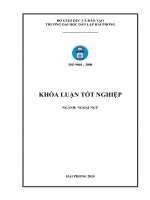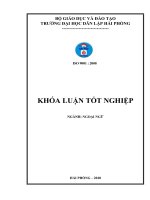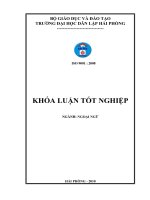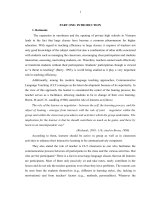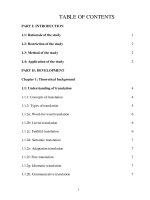A STUDY ON HYPONYMY AND MERONYMY IN LEXICAL SEMANTICS
Bạn đang xem bản rút gọn của tài liệu. Xem và tải ngay bản đầy đủ của tài liệu tại đây (542.38 KB, 64 trang )
BỘ GIÁO DỤC VÀ ĐÀO TẠO
TRƯỜNG ĐẠI HỌC DÂN LẬP HẢI PHỊNG
-------------------------------
ISO 9001 : 2008
KHĨA LUẬN TỐT NGHIỆP
NGÀNH: NGOẠI NGỮ
HẢI PHÒNG – 2010
HAIPHONG PRIVATE UNIVErSITY
FOREIGN LANGUAGES DEPARTMENT
-----------------------------------
GRADUATION PAPER
A STUDY ON HYPONYMY AND MERONYMY IN
LEXICAL SEMANTICS
By:
PHAM THI BICH HONG
Class:
NA1002
Supervisor:
DANG THI VAN, M.A
HAI PHONG – JUNE 2010
BỘ GIÁO DỤC VÀ ĐÀO TẠO
TRƯỜNG ĐẠI HỌC DÂN LẬP HẢI PHÒNG
--------------------------------------
Nhiệm vụ đề tài tốt nghiệp
Sinh viên: ..............................................Mã số: .......................................
Lớp: .............................Ngành:.................................................................
Tên đề tài:.................................................................................................
.................................................................................................
.................................................................................................
.................................................................................................
Nhiệm vụ đề tài
1. Nội dung và các yêu cầu cần giải quyết trong nhiệm vụ đề tài tốt
nghiệp
( về lý luận, thực tiễn, các số liệu cần tính tốn và các bản vẽ).
……………………………………………………………………………..
……………………………………………………………………………..
……………………………………………………………………………..
……………………………………………………………………………..
……………………………………………………………………………..
……………………………………………………………………………..
……………………………………………………………………………..
……………………………………………………………………………..
2. Các số liệu cần thiết để thiết kế, tính tốn.
……………………………………………………………………………..
……………………………………………………………………………..
……………………………………………………………………………..
……………………………………………………………………………..
……………………………………………………………………………..
……………………………………………………………………………..
……………………………………………………………………………..
……………………………………………………………………………..
……………………………………………………………………………..
3. Địa điểm thực tập tốt nghiệp.
……………………………………………………………………………..
……………………………………………………………………………..
……………………………………………………………………………..
CÁN BỘ HƯỚNG DẪN ĐỀ TÀI
Người hướng dẫn thứ nhất:
Họ và tên: .............................................................................................
Học hàm, học vị: ...................................................................................
Cơ quan công tác: .................................................................................
Nội dung hướng dẫn: ............................................................................
Người hướng dẫn thứ hai:
Họ và tên:.............................................................................................
Học hàm, học vị:...................................................................................
Cơ quan công tác:.................................................................................
Nội dung hướng dẫn:............................................................................
Đề tài tốt nghiệp được giao ngày 12 tháng 04 năm 2010
Yêu cầu phải hoàn thành xong trước ngày 10 tháng 07 năm 2010
Đã nhận nhiệm vụ ĐTTN
Đã giao nhiệm vụ ĐTTN
Người hướng dẫn
Sinh viên
Hải Phòng, ngày tháng năm 2010
HIỆU TRƯỞNG
GS.TS.NGƯT Trần Hữu Nghị
PHẦN NHẬN XÉT TÓM TẮT CỦA CÁN BỘ HƯỚNG DẪN
1. Tinh thần thái độ của sinh viên trong quá trình làm đề tài tốt
nghiệp:
……………………………………………………………………………..
……………………………………………………………………………..
……………………………………………………………………………..
……………………………………………………………………………..
……………………………………………………………………………..
……………………………………………………………………………..
……………………………………………………………………………..
……………………………………………………………………………..
2. Đánh giá chất lượng của khóa luận (so với nội dung yêu cầu đã đề ra
trong nhiệm vụ Đ.T. T.N trên các mặt lý luận, thực tiễn, tính tốn số
liệu…):
……………………………………………………………………………..
……………………………………………………………………………..
……………………………………………………………………………..
……………………………………………………………………………..
……………………………………………………………………………..
……………………………………………………………………………..
……………………………………………………………………………..
……………………………………………………………………………..
……………………………………………………………………………..
3. Cho điểm của cán bộ hướng dẫn (ghi bằng cả số và chữ):
……………………………………………………………………………..
……………………………………………………………………………..
……………………………………………………………………………..
Hải Phòng, ngày ….. tháng ..… năm 2010
Cán bộ hướng dẫn
(họ tên và chữ ký)
NHẬN XÉT ĐÁNH GIÁ
CỦA NGƯỜI CHẤM PHẢN BIỆN ĐỀ TÀI TỐT NGHIỆP
1. Đánh giá chất lượng đề tài tốt nghiệp về các mặt thu thập và phân tích tài
liệu, số liệu ban đầu, giá trị lí luận và thực tiễn của đề tài.
2. Cho điểm của người chấm phản biện :
(Điểm ghi bằng số và chữ)
Ngày.......... tháng......... năm 2010
Người chấm phản biện
TABLE OF CONTENTS
Page
Acknowledgements
PART ONE: INTRODUCTION .................................................................... 1
1.
Rationale of the study................................................................................ 1
2.
Aims of the study ...................................................................................... 1
3.
Scope of the study ..................................................................................... 2
4.
Design of the study.................................................................................... 2
PART TWO: DEVELOPMENT ................................................................... 4
Chapter I- The theoretical background ....................................................... 4
1. Lexical Semantics ......................................................................................... 4
1.1. Lexical Semantics .................................................................................. 4
1.2. Word meaning ........................................................................................ 4
1.3. Sense relation ......................................................................................... 5
2. Hyponymy ..................................................................................................... 6
2.1. Definition .............................................................................................. 6
2.2. Ingredients ............................................................................................. 6
2.3. Types ..................................................................................................... 8
2.4. Some features ........................................................................................ 9
2.4.1. The entailment ............................................................................ 9
2.4.2. Substitutive possibility................................................................ 9
2.4.3. Taxonymy as a subtype of hyponymy ...................................... 10
2.4.4. Synonymy as the special case of Hyponymy ............................ 11
3. Meronymy ................................................................................................... 11
3.1. Definition ............................................................................................ 12
3.2. Ingredients ........................................................................................... 12
3.3. Types ................................................................................................... 13
3.3.1. Component – integral object ..................................................... 14
3.3.2. Member – collection ................................................................. 14
3.3.3. Portion – mass ........................................................................... 15
3.3.4. Stuff – object ............................................................................. 16
3.3.5. Feature – activity ....................................................................... 16
3.3.6. Place – area ............................................................................... 17
3.4. Some features ...................................................................................... 17
3.4.1. The close relationship between members in a Meronymy ....... 17
3.4.2. The constant principle in the semantic relation of Meronymy . 18
3.4.3. Properties of Meronymy ........................................................... 18
Chapter II- Contrastive Analysis of Hyponymy and Meronymy ............. 20
1. Compare of Hyponymy and Meronymy ..................................................... 20
1.1. Hierarchies ........................................................................................... 20
1.1.1. Hierarchies ................................................................................. 20
1.1.2. Dominance ................................................................................. 21
1.1.3. Differentiation ............................................................................ 23
1.2. Lexical hierarchy .................................................................................. 24
1.3. Lexical gaps ......................................................................................... 27
1.3.1. Superordinate missing ................................................................ 27
1.3.2. Subordinate missing ................................................................... 29
2. Contrast of Hyponymy and Meronymy ...................................................... 31
2.1. Lexical relation..................................................................................... 31
2.2. Transitive relation ................................................................................ 32
2.3. The expansion of lexical item category ............................................... 35
Chapter III- Implication .............................................................................. 37
1. Some problems of Hyponymy and Meronymy ........................................... 37
1.1. Difficulties in recognizing Hyponymy and Meronymy ....................... 37
1.1.1. Difficulties in recognizing Hyponymy ...................................... 37
1.1.2. Difficulties in recognizing Meronymy....................................... 38
1.2. Difficulties in distinguishing Hyponymy and Meronymy ................... 39
1.2.1. The relativity in both Hyponymy and Meronymy ..................... 39
1.2.2. Quasi-relation ............................................................................. 39
2. Some suggestions to problems .................................................................... 40
2.1. Suggestions to recognize Hyponymy and Meronymy ......................... 40
2.1.1. Suggestions to recognize Hyponymy......................................... 40
2.1.2. Suggestions to Recognize Meronymy ....................................... 42
2.2. Suggestions to distinguish Hyponymy and Meronymy ....................... 43
2.2.1. Suggestion to difficulty of Relativity ......................................... 43
2.2.1. Suggestion to difficulty of Quasi-relation.................................. 44
PART THREE: CONCLUSION ................................................................. 45
1. Summary of the study .............................................................................. 45
2. Suggestion for the further study ............................................................... 46
References ...................................................................................................... 47
Appendix ........................................................................................................ 48
FIGURES
Page
Figure 1 ........................................................................................................... 5
Figure 2 ........................................................................................................... 7
Figure 3 ........................................................................................................... 8
Figure 4 ......................................................................................................... 12
Figure 5 ......................................................................................................... 13
Figure 6 ......................................................................................................... 14
Figure 7 ......................................................................................................... 20
Figure 8 ......................................................................................................... 21
Figure 9 ......................................................................................................... 22
Figure 10 ....................................................................................................... 23
Figure 11 ....................................................................................................... 23
Figure 12 ....................................................................................................... 25
Figure 13 ....................................................................................................... 26
Figure 14 ...................................................................................................... 27
Figure 15 ....................................................................................................... 28
Figure 16 ....................................................................................................... 29
Figure 17 ....................................................................................................... 30
Figure 18 ....................................................................................................... 38
Figure 19 ....................................................................................................... 38
Figure 20 ....................................................................................................... 41
Figure 21 ....................................................................................................... 41
Figure 22 ....................................................................................................... 42
ACKNOWLEDGEMENTS
This study, although, is carried out in a few month, it is the result of the
enormous amount of effort not only of mine buy also many other people.
Therefore, I would like to thank everyone who helps me finish this graduation
paper.
First of all, I would like to express my deepest gratitude to my supervisor,
Mrs. Dang Thi Van who plays an important role in my study. I am very
thankful for her enthusiastic instruction and heartfelt encouragement which
are the motivations to help me complete the study.
Next, I would like to thank teachers in Foreign Language Department of
Haiphong Private University for their assistance in my knowledge during the
last four years, which distributes cruelly to my study today.
Finally, it is impossible to mention the mental assistance of my family and
my friends. They have given me the giant encourage which help me a lot in
overcoming difficulties in the process of carrying out the study.
Haiphong, June 2010
Pham Thi Bich Hong
PART ONE: INTRODUCTION
1. Rationale
Semantics along with other subjects like Grammar. Phonology and
Phonetics, Lexical, so on stands in the system of academic language. It is
researched systematically with a lot of different points of view and
approaches which are argued by many famous linguisticians like J. Lyons
(Cambridge University); Curse, D.A (Cambridge University); Chaffin, R &
Winston, M.E (Trenton State College); Herman D (Hamilton College); and so
on.
Semantics is not only researched but also learned in universities. To major
students at Haiphong private university like me, semantics is a new subject in
the curriculum, which brings us both excite and challenge. Furthermore, for
myself, it really attracts me in the studying at class for its strangeness,
especially Hyponymy and Meronymy. These two types of the sense relations
are popular in life particularly in scientific field. They are used to express
hierarchical relations. Besides, they also show the certainly mutual
correspondence and distinction as well, which urges me to study this issue
more profoundly.
That is the reason why Hyponymy and Meronymy are chosen to be the
graduation paper of mine. With more detailed aspects in these two sense
relations, in my hope, it will be much easier for teachers and learners to enrich
their knowledge in semantics.
2. Aims of the study
With the study, I hope to satisfy readers with knowledge gap in Semantics
and open new direction for further study. Specially, I would like to achieve
the following aims:
- State certain aspects in Hyponymy and Meronymy.
- Point out the similarity and the distinction between Hyponymy and
Meronymy.
- Show some difficulties in recognizing and distinguishing Hyponymy
and Meronymy.
- Give some suggestions for further study.
3. Scope of the study
Hyponymy, Meronymy and the distinction between them are complicated
and profound issues in Lexical semantics, which relate to a lot of lexical
relations like Taxonymy, Meronomy, and Hierarchical relation. Therefore it is
difficult for me to analyze clearly their relationship between them and the two
sense relations.
Due to the limited time and knowledge, my study just emphasizes on
outstanding aspects of the two sense relations as mentioned in the design. I
always percept my restricted understanding in Semantics, generally speaking
and Sense relations individually speaking, therefore it will be not wise if
further issues of Hyponymy and Meronymy like their relationship with other
semantic relations, their application in detail, etc. are mentioned with the
carelessness in the study. Conversely, the aspects such as Definition, Types,
Features, Contrastive analysis of Hyponymy and Meronymy will be stated in
detail in the study.
In my hope, the study will not be too restricted and can give the reader a
little referential knowledge.
4. Design of the study
The study includes three main parts: Introduction, Development,
Conclusion.
The first, Introduction, gives information about the reason, scope, outline,
and aims of my study.
The second one, Development- the main part of the study, denotes issues
relating two types of branching lexical hierarchy.
Chapter I will be the statement of the theoretical background, in which the
concept of the Hyponymy and Meronymy will be mentioned as well as their
characteristics and types will be denoted.
Chapter II, the main one, presents the distinction between these two
semantic relations including the distinction of the lexical relation, the
transitive relation, the hierarchical relation, the expansion of lexical units of
the two semantic relations.
Chapter III is to mention some problems in recognizing and differentiating
Hyponymy and Meronymy. Solutions suggested for dealing with the problems
are also stated.
The last part, Conclusion, giving the overview of the study comes with the
summary and the orientation for further research.
PART TWO: DEVELOPMENT
Chapter I – THEORITICAL BACKGROUND
1. Lexical semantics
1.1. Lexical semantics
Lexical semantics is a subfield of linguistic semantics. It is the study of
how and what the words of a language denote (Pustejovsky, 1995). Words
may either be taken to denote things in the world, or concepts, depending on
the particular approach to lexical semantics.
Lexical semantics covers theories of the classification and decomposition
of word meaning, the differences and similarities in lexical semantic structure
between different languages, and the relationship of word meaning to
sentence meaning and syntax .
Scope of lexical semantics refers to three issues which are closely
interrelated:
Structure of lexical meaning
Semantic structures (meanings) of words and how the meanings of
words are interrelated in the language
Semantic structure of dictionaries
1.2. Word meaning
Before mentioning the notion of word meaning, it should be mentioned the
notion of ‚word‛. There are many definitions of what word is, but it can be
defined to be name or label for thing (Nguyen Hoa, 2002). Word is defaulted
by human to call an object or phenomenon in reality. In the relationship with
word meaning, word is representative for Language which is one of Mind,
Language, and Wold. It is possible to describe the relation in the following
triangle:
Language
Mind
World
Fig.1
Hoa (2002:17)
Therefore, word meaning can be defined as reflect reality or express
human conceptualization of reality, as it were.
1.3. Sense relations
While reference is mentioned as an external meaning relation, which is the
relationship between a word and the entry that it ‘refers to’ in the physical
world or the world in our experience (Jackson & Amvela, 2000), sense is an
internal meaning relation. It refers to the relationship between words within
the vocabulary.
Relations between concepts, senses or meanings should not be confused
with relations between the terms, words, expressions or signs that are used to
express the concepts. It is, however, common to mix both of these kinds of
relations under the heading "semantic relations" (i.e., Cruse, 1986; Lyons,
1977; Malmkjær, 1995 & Murphy, 2003)
For example, in the set: ‚slay, kill, murder, etc.‛ all the member show
different expressions of an action to deprive one’s life, therefore these words
is called synonyms and the relation between them is Synonymy. Similarly,
there are the other sense relations such as: Antonymy along with Synonymy
is the most obvious sense relations and Hyponymy, Meronymy, Homonymy,
etc.
Sense relations are paradigmatic. It means that words in the same sense
relation are interchangeable for all together (e.g. ‚hostile‛ and ‚friendly‛ can
substituted for each other because they are in the same relation of Antonymy).
2. Hyponymy
2.1. Definition
The relation between two classes in lexicon often present in four basic
relations. They are identity (two classes have the same members), inclusion
(one class is entirely in another class), overlap (two classes have the same
members but each one has its own members), and disjunction (two classes
have no members in common). The lexical relation corresponding to the
inclusion one class in another is Hyponymy (Cruse, 1986). For instance, class
‚chair‛ is included in class ‚furniture‛ because the former belong to the latter.
In sense relations, Hyponymy is regarded as the relation of
generality/specificity. If we want to refer to something, e.g. a dog, we have
several possibilities to express this: We could say ‘spaniel’ (only, of course, if
we talk about a spaniel), ‘dog’ or ‘animal’. It becomes clear that these lexical
items are of ‚different levels of specificity‛ (Cruse, 1975) , and what we
finally say depends on our point of view, whereas no one will disagree that
‘spaniel’ is more specific than ‘dog’, which itself is more specific than
‘animal’.
From two above opinions of the term of Hyponymy, it is possible to define
that Hyponymy is a relation of inclusion between two classes or two words in
which one class or word more general in term of meaning involves another
class or word whose meaning is more specific.
2.2. Ingredients
Hyponymy expresses the relationship between two words, in which the
word belonging to the genus and more general is called Superordinate or
Hypernym, the other carrying the characteristics of the species and more
specific is called Hyponym.
Hypernym refers to words carrying extensional meaning. It is broad
enough to cover the Hyponym. For example, the word ‚animal‛ is Hypernym
of the words ‚dog‛, cat, mouse, etc.‛ because it holds notion of all the words ‚
dog, cat, mouse‛; whereas, Hyponym refers to words presenting inclusion
meaning. It covers both the general meaning of its Superordinate and the
specific one of itself. For instance, the word ‚rose‛ carrying characteristics of
a flower, in general, it also includes its individual features.
Sometimes a Superordinate may be a Superordinate to itself. For instance,
the word animal may only include beasts like tiger, lion, elephant, cow, horse
and is a co-hyponym of human. But it is also the Superordinate to both human
and animal in contrast to bird, fish, and insect, when it is used in the sense of
mammal. Furthermore, animal is also the Superordinate to bird, fish, insect
and mammal in contrast to plant.
animal
bird
fish
insect
mammal
human
animal
Lion
tiger
elephant
Fig.2
(e/viewthread.php?tid=1425)
From the other point of view, the hyponym's point of view, animal is a
Hyponym of itself, and may be called Auto-hyponym in that the same lexical
item can operate at both Superordinate and Subordinate levels; for example,
‚man‛ contrasts with ‚animal‛ at one level, but at a lower level it contrasts
with
‚woman‛
(in
effect,
‚a
man
is
a
kind
of
man‛).
The relation between Hypernym and Hyponym is asymmetrical relation, in
which a Hypernym can have many Hyponyms that are types of their
Hypernym. The following example will illustrate the statement:
living things
creature
animal
insect
Level 1
plant
tree
flower vegetable
Level 2
Level 3
Fig. 3
(e/viewthread.php?tid=1425)
In the tree-gram, the sense relation of Hyponymy is express in levels. The
former the level is, the more general it is. The relation between levels is called
hierarchical relation. Level 1 called mother-nodes is Hypernym of level 2
(daughter-nodes) and level 3. Similarly, level 2 is Hypernym of level 3. The
relation between words in the same level is named as sister-nodes (creature,
plant) and in the sense relation of Hyponymy; they are called Co-hyponym.
Co-hyponyms in Hyponymy are strict imcompatibles (Cruse, 1986).
2.3. Types
Murphy (2003) & Chaffin (1984) argue there are different kinds of
Hyonymy according to the property of concept, and define six types of
Hyponymy: perception (horse-animal), function (car-vehicle), geography
(Russia-country), activity (chess-game), state (fear-emotion and action (frycook).
Moreover, Miller (1998) defines two main types of the kind-of relation:
Taxonymic and functional Hyponymy, in which Taxonymy plays the central
role in the lexical hierarchy. While Taxonymy is the ‚is-a-kind-of‛ relation,
Functional Hyponymy is known as the ‚is-used-as-a-kind-of‛ relation. For
example, cow is in a taxonomic relation to animal (a cow is an animal), but in
a functional relation to livestock (a cow functions as livestock). The functional
relation is more tenuous because it is not a logically necessary relation: not
every cow is livestock; not every dog is pet. Taxonymy, one the other hand, is
more analytic.

